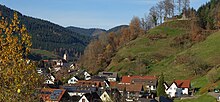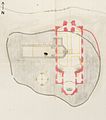St. Bartholomew (Oberwolfach)
St. Bartholomäus is the Roman Catholic parish church of Oberwolfach , a community on the Wolf River in the Ortenau district of Baden-Württemberg . The parish together with St. Laurentius in Wolfach and St. Roman in the mountain village of the same name form the pastoral care unit An Wolf and Kinzig of the Archdiocese of Freiburg .
About the history and shape of the church, a work of the baroque , has u. a. the teacher and art historian Hermann Brommer researched. According to him, the materially poor congregation with its always lovingly cared for church has created “a piece of heaven on earth” in the Baroque sense.
history
In the 13th century, Oberwolfach belonged to the area of the noble lords of Wolfach, like the adjoining Wolfach to the south at the confluence of the Wolf into the Kinzig , whose castle, now in ruins , was on a mountain cone above the district of Oberwolfach Church . It was probably they who founded the parish in the late 11th or early 12th century - at a time when the patronage of the Apostle Bartholomew was flourishing. Oberwolfach was first distinguished from Wolfach in 1275, when his church was first mentioned in the Liber decimationis of the Diocese of Constance , where apart from a "rector eccelsie Wolfach inferioris", "pastor of the church of Niederwolfach", from a "rector ecclesiae superioris Wolfach", "Pastor of the Church of Oberwolfach" is the talk. At the end of the 13th century, both places fell by inheritance to Count Friedrich I von Fürstenberg , and they stayed with the Fürstenbergers until they came to the Grand Duchy of Baden in the wake of the Reichsdeputationshauptschluss 1806 . The Reformation in Wolfach and Oberwolfach was an episode that lasted from 1543 to 1548. In 1821 the neighboring parishes came to the Archdiocese of Freiburg. In 1955, as a branch of St. Bartholomew in the north and thus located in town center Oberwolfach district Walke , the church of St. Mary built. The co-patron saint there is the blessed Luitgard von Wittichen , who worked in Oberwolfach for several years before she founded the Wittichen monastery in 1324 .
Building history
- Salzmann's plans
Only the floor plan of the medieval church is known, which was recorded by the Fürstenberg master builder Franz Joseph Salzmann on the occasion of the new building in the 18th century. After that it was geosted and had a polygonal closed choir. In August 1753, pastor Joan Antony Baur from Donaueschingen (pastor in Oberwolfach from 1746 to 1753) wrote to Joseph Wilhelm Ernst von Fürstenberg and his administration that "the ancient little church" was much too small, in poor condition inside and out, the roof structure was in ruins, the helmet of the tower in danger of falling. The Fürstenberg bailiff confirmed and Baur's successor Georg Wilhelm Ackermann from Villingen (pastor in Oberwolfach from 1753 to 1771). repeated the complaint.
Salzmann suggested building the new church on the site of the old one, but turned it by 90 ° opposite it, with the choir in the south, and thus parallel to the slope instead of perpendicular to the slope as before. The counter-proposal to move to the Walke was rejected by the princely administration. From 1755 the new building was built according to Salzmann's plans and was consecrated on July 30, 1762 by the Constance Auxiliary Bishop Count Franz Carl Josef Fugger . Today's altars came into the church later.
From 1873 to 1875, 1991 and around 2012 St. Bartholomew was thoroughly renovated.
building
A long staircase leads from the church square to the northern facade. There the tower rises on three floors, following the suggestion of Pastor Ackermann with curved decorative gables instead of Salzmann's simple triangular gables. “The new church tower uses simple means to develop its solemn character, pointing towards the sky.” The north facade swings back to the nave in an arched manner , a simple hall with five-axis round-arched windows divided by pilaster strips . It has a flat ceiling , sparsely stuccoed with rococo ornaments, over a hollow. Inside, the side walls swing in an arched manner towards the choir arch . The choir closes round and is accompanied by sacristies on the side.
Furnishing
The three ceiling paintings in the nave were created by Dominik Weber (1819–1887) from Freiburg during the first complete restoration in 1875: the Holy Family , the twelve-year-old Jesus in the temple ( Lk 2,41ff EU ) and the blessing of Jesus for children ( Mt 19,13–15 EU ).
- High altar
The carpenters and sculptors are not known for any of the three altars. The magnificent high altar was acquired from St. Laurentius in Wolfach in 1774 under Pastor Michael Baumann from Unadingen (successor to Ackermann and pastor in Oberwolfach from 1771 to 1790) . Around the tabernacle, accompanied by the busts of the apostles Peter with his keys and Paul with his sword, and around the exposure niche with a pelican above, symbol of the sacrificing Jesus, a dance of ten angels swings. On the main floor, between two blue and white marbled columns and a pilaster, Bartholomäus stands on each side, who, according to his martyrdom - he was tortured - wears his peeled skin over his arm. The saints Wendelin and Sebastian stand to one side . On the upper floor Maria is painted as Immaculata , immaculately received, again in a dance of angels, two large and six small. “Baroque angels as good spirits want to show the viewer that they are very close to God. With the polished white frames, all the angels appear removed from the real space. And the rays of the divine sun flash through their gilded cloths and wings. "
The side altars are symmetrical and equally designed on both sides of the choir arch. The left one was donated by the Oberwolfacher Scapular Brotherhood , founded in 1706 . The signed picture by the Rottenburg painter Johann Herrmann (1749–1807) shows the legendary presentation of the scapular to the saint of the Carmelite order, Simon Stock . Below is the redemption of souls from purgatory .
The picture on the right side altar shows Jesus on the cross, sparse, without additions, after the signature “1818. Moser px. ”Painted by Franz Joseph Moser (1783–1865) from Wolfach. Left and right are statues of repentant sinners, namely Peter with keys and the rooster, which reminded him of the denial of Jesus ( Mk 14.66-72 EU ), and Mary Magdalene , who was equated with the woman who was Jesus' feet washed ( Lk 7.36-50 EU ).
The new free-standing wrought-iron folk altar , which according to the Second Vatican Council allows Mass versus populum , was created by the sculptor Alfred Erhart from 1973 to 1974.
The crucifixion group on the right aisle wall and the pulpit with rocaille ornaments on the basket and the Archangel Michael and two little angels on the sound cover on the left aisle wall date from the time of construction or shortly thereafter .
After a first organ had become unusable, a second one from the workshop of Mathias Burkard (1838–1922) in Heidelberg was procured from 1877 to 1879 . This was restored from 1943 to 1944 by M. Welte & Söhne in Freiburg im Breisgau and most recently in 1990 by Waldkircher Orgelbau Jäger & Brommer - "the only larger Burkard organ in southern Baden".
literature
- Hermann Brommer : Oberwolfach parish church of St. Bartholomew. Kunstverlag Josef Fink, Lindenberg 2012, ISBN 978-3-89870-763-3 .
- Oberwolfach. In: Landesarchivdirektion Baden-Württemberg (ed.): The state of Baden-Württemberg. Official description by district and municipality. Volume VI. Freiburg administrative district. Kohlhammer Verlag, Stuttgart 1982. ISBN 3-17-007174-2 , pp. 431-432 ( digitized at Landeskunde discover Baden-Württemberg online ).
- Kurt-Erich Maier: Oberwolfach. The story of a Black Forest community in Wolftal. Oberwolfach municipality 1958.
- Max Wingenroth : The art monuments of the district of Offenburg (= The art monuments of the Grand Duchy of Baden Volume 7). Mohr Siebeck Verlag, Tübingen 1908, pp. 692-693 ( digitized version ).
- Joseph Ludolf Wohleb: The Kinzigtäler church buildings by the Fürstenberg architect Franz Joseph Salzmann (1724–1786). II. In: The Ortenau. Journal of the Historical Association for Mittelbaden 31, 1951, pp. 51–70 ( digitized version ).
- Dagmar Zimdars u. a. (Ed.): Georg Dehio, Handbuch der Deutschen Kunstdenkmäler ( Dehio-Handbuch ) Baden-Württemberg II . Deutscher Kunstverlag, Berlin / Munich 1997, ISBN 3-422-03030-1 , p. 508.
References and comments
- ↑ a b Brommer 2012, p. 29.
- ↑ Brommer 2012, p. 5.
- ↑ Wingenroth 1908; the quote on "Niederwolfach" there p. 683.
- ↑ Pastoral care unit to Wolf and Kinzig
- ↑ Maier 1958, p. 193.
- ↑ a b Maier 1958, p. 183.
- ↑ Brommer 2012, p. 6.
- ↑ Brommer 2012, p. 11.
- ↑ Baumann wrote, when he applied to be replaced by his cousin in 1790, that Oberwolfach was the most arduous parish in the Kinzigtal because it "has the largest part of the most remote farms on the steepest mountains, where you can go at 3 hours and above, but in winter has to crawl almost more with a lot of snow. Not every subject is suitable for this parish. ”Maier 1958, p. 183.
- ↑ Brommer 2012, p. 13.
- ↑ Brommer 2012, p. 15.
Web links
Coordinates: 48 ° 18 ′ 59.9 ″ N , 8 ° 13 ′ 0.3 ″ E

















